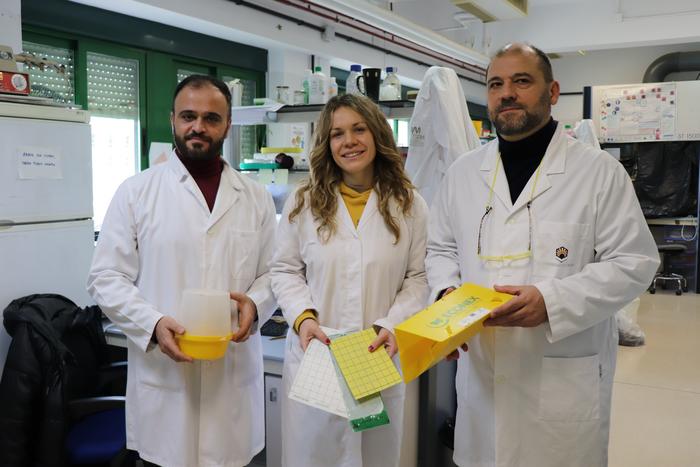The olive fly, scientifically known as Bactrocera oleae, poses a significant threat to the quality of olive oil production in numerous regions, particularly in Mediterranean countries where olive cultivation is a cornerstone of agriculture and culinary heritage. As this pest continues to jeopardize both crop yield and oil quality, researchers at the University of Córdoba are pioneering innovative monitoring techniques that promise to enhance control measures through more effective pest management strategies. The findings from their recent field study indicate a transformative approach that may change the landscape of olive fly monitoring.
Traditionally, the monitoring of olive fly populations has relied heavily on outdated methods lacking scientific validation. According to researcher Meelad Yousef, the existing systems fail to provide reliable data needed for integrated pest management (IPM) regimes. IPM emphasizes minimizing the use of synthetic insecticides by focusing on biological control methods and better monitoring techniques. Thus, establishing an accurate population monitoring system is crucial for optimizing pest control actions while minimizing chemical applications.
The research team undertook a comprehensive study over two years, primarily across the provinces of Córdoba and Cádiz. The objective was straightforward yet ambitious: identify the most effective traps for monitoring olive fly populations. The results were revealing; smaller, double-sided yellow adhesive panels, measuring 10 cm by 25 cm, emerged as the most effective traps. Their efficacy was evidenced by the researchers’ data, which indicated that deploying these traps at a density of 15 per hectare provided the most accurate population estimates.
Interestingly, the study also revealed that even a lower density of just four traps per hectare could furnish useful population estimates. These findings are set to inform the revisions to Spain’s Integrated Pest Management Guide, which has previously recommended outdated density figures, including six traps for plots spanning 300 hectares. This adjustment is poised to directly affect pest management practices and improve growers’ response times.
Various trap types were evaluated in the course of the research, including McPhail traps, which have long been a standard in pest monitoring. However, the yellow adhesive panels were ultimately preferred due to their ability to specifically target the olive fly while minimizing the capture of beneficial insects. The study benchmarked multiple colors of traps, determining that yellow was the clear winner in attracting olive flies, enabling precision in monitoring efforts that could enhance pest management.
In an intriguing twist, the smaller size of the 10×25 cm trap proved more effective than larger alternatives. Despite capturing a similar number of flies, the smaller traps enticed fewer non-target species, highlighting a crucial facet of trap design that had been overlooked in existing guidelines. Such revelations are indicative of the broader implications of the research for refining pest monitoring protocols.
The study did not stop at trap design; it delved deeper into understanding the relationship between olive fly populations and the varietal differences among olive trees. The researchers discovered that not all olive varieties are equally affected by olive fly infestations. For instance, the Frantoio and Empeltre varieties exhibited different damage responses even when exposed to similar fly population densities. This finding underscores the importance of variety-specific monitoring and management strategies that could mitigate the impact of olive flies based on their host tree type.
As the research gains traction, it sets the groundwork for developing electronic traps capable of relaying real-time data back to growers and pest control specialists. This technological advancement promises to revolutionize the way olive fly populations are managed, allowing for timely interventions that could significantly curb the degree of crop damage. The integration of real-time data collection could mark a substantial leap forward in the efficacy of pest management system deployments.
Aside from the immediate implications for pest control, the research also emphasizes the ecological balance necessary to maintain olive production while reducing reliance on chemical treatments. By utilizing non-invasive monitoring techniques, growers can gather intelligence that allows them to act responsibly, aligning agricultural practices with environmental stewardship.
The journey of the research team at the University of Córdoba reflects a commitment to not only safeguarding olive production but also enhancing the sustainability of agricultural practices more broadly. Their integrated approach to entering the realm of modern pest management demonstrates the potential for innovation rooted in scientific inquiry, a beacon for future research endeavors in entomology and agricultural science.
In conclusion, the findings from this study illustrate a pivotal development in monitoring olive fly populations, emphasizing the effectiveness of smaller, strategically distributed yellow adhesive traps. This advancement is not just a methodological shift but a deeper understanding of pest dynamics, varietal susceptibility, and ecological considerations in olive cultivation. As these strategies take hold, they offer the promise of a more sustainable future for olive growers while preserving the integrity and quality of one of the world’s most cherished culinary ingredients.
Subject of Research: Monitoring olive fruit fly populations
Article Title: Optimizing decision-making potential, cost, and environmental impact of traps for monitoring olive fruit fly Bactrocera oleae (Rossi) (Diptera: Tephritidae)
News Publication Date: 8-Jan-2025
Web References: DOI: 10.1093/jee/toae296
References: Flora Moreno-Alcaide, Enrique Quesada-Moraga, Pablo Valverde-García, Meelad Yousef-Yousef, Journal of Economic Entomology, Volume 118, Issue 1, February 2025, Pages 219–228
Image Credits: Universidad de Córdoba
Keywords: Pest control, Population ecology, Entomology, Adhesives, Controlled trials, Agricultural sciences, Olive oil production.




